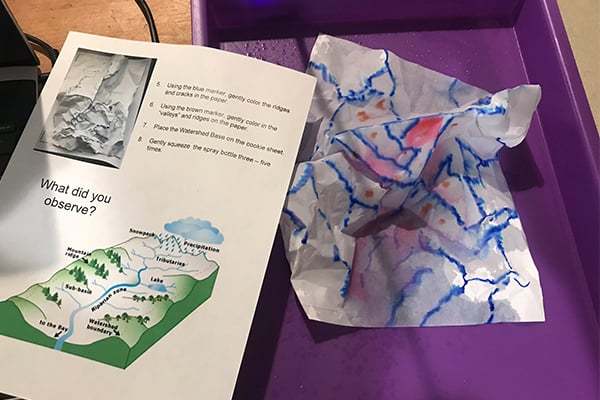 Students
at
Ellis
Elementary
School
recreated
a
watershed
experiment
as
a
part
of
the
fourth-grade
curriculum
covering
water
cycles
and
watersheds
in
Virginia.
Alicia
Schrank,
fourth
grade
teacher
at
Ellis
Elementary,
led
her
class
through
the
"crumpled
paper"
watershed
experiment.
Students
at
Ellis
Elementary
School
recreated
a
watershed
experiment
as
a
part
of
the
fourth-grade
curriculum
covering
water
cycles
and
watersheds
in
Virginia.
Alicia
Schrank,
fourth
grade
teacher
at
Ellis
Elementary,
led
her
class
through
the
"crumpled
paper"
watershed
experiment.The experiment involves taking a piece of paper and crumpling it up, then opening it a little to see the small ridges and valleys created by the crumpling. This mirrors the Blue Ridge mountains and the valleys. Students then trace along the ridgelines using a blue colored marker to represent streams and rivers. Then they spray the paper using a spray bottle to represent a rainstorm over the land. The students observe how the water travels down the ridges and collects downstream and discuss how the collection spot could represent the Chesapeake Bay.
Schrank explained, "We focus on not only what a watershed is but how everything that occurs in the watershed affects the water and thus affecting all humans and wildlife habitats within it. The students truly learn what it means when we say, 'we all live downstream.'"
The class proceeds to add brown dots to the land using a colored marker to represent pollution. To connect the lesson back to a personal experience, Schrank asks the students, "What type of pollution do you see around your own neighborhoods?" She then has them spray the paper, to show students how the brown mixed with the blue and represents how trash could get mixed in with our water.
Lastly, the students draw large circles with a red marker to represent landfills or factories that create a lot of pollution. One of the students shared, "No, now the water will be really dirty!" as they sprayed the land again.
This brought the class back to the discussion point of what it means to say, "we all live downstream," and one student stated that it didn't matter where Schrank sprayed because the water ran all over the land, polluting the streams, rivers, and bodies of water where it collected. The class concluded the lesson with ideas on how fourth graders can protect the Chesapeake Bay and influence the adults in their homes to be more aware of how their actions affect everyone in the watershed.
"I always love doing this lab with the students having their own crumpled paper 'land' and I wanted them to have the same experience in the virtual learning setting. I find this experiment stays with students and makes them look differently at the world around us, and just how much we impact it, both positively and sometimes like in this experiment, negatively through pollution, and being more conscious of our actions," shared Schrank.
